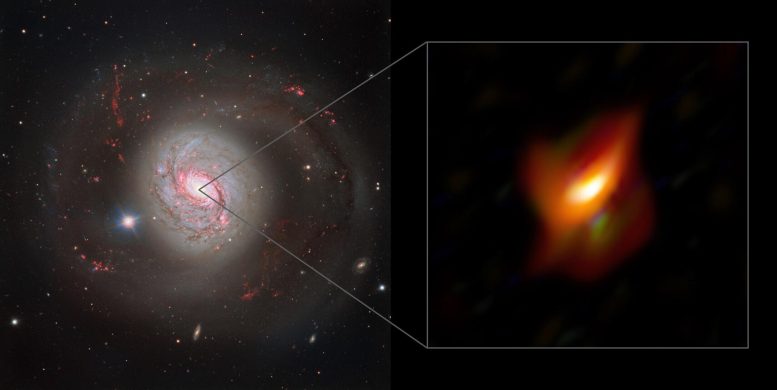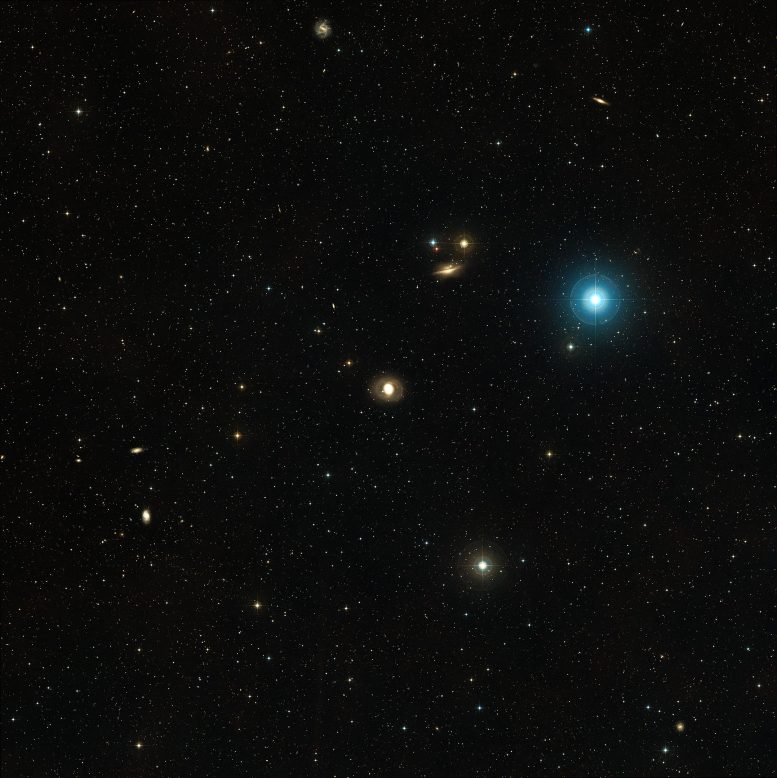This illustration shows what the core of Messier 77 might look like. As other active galactic nuclei, the central region of Messier 77 is powered by a black hole that is surrounded by a thin accretion disc, which itself is surrounded by a thick ring or torus of gas and dust. In the case of Messier 77, this thick ring completely obscures our view of the supermassive black hole.
This active galactic nucleus is also believed to have jets, as well as dusty winds, that flow out of the region around the black hole perpendicularly to the accretion disc around it. Credit: ESO/M. Kornmesser and L. Calçada
The European Southern Observatory’s
The left panel of this image shows a dazzling view of the active galaxy Messier 77 captured with the FOcal Reducer and low dispersion Spectrograph 2 (FORS2) instrument on ESO’s Very Large Telescope. The right panel shows a blow-up view of the very inner region of this galaxy, its active galactic nucleus, as seen with the MATISSE instrument on ESO’s Very Large Telescope Interferometer. Credit: ESO/Jaffe, Gámez-Rosas et al.
Active galactic nuclei (AGNs) are extremely energetic sources powered by supermassive black holes and found at the center of some galaxies. These black holes feed on large volumes of cosmic dust and gas. Before it is eaten up, this material spirals towards the black hole, and huge amounts of energy are released in the process, often outshining all the stars in the galaxy.
Astronomers have been curious about AGNs ever since they first spotted these bright objects in the 1950s. Now, thanks to ESO’s VLTI, a team of researchers, led by Violeta Gámez Rosas from Leiden University in the Netherlands, have taken a key step towards understanding how they work and what they look like up close. The results are published today (February 16, 2022)y in Nature.
Active galactic nuclei (AGNs) are extremely energetic sources powered by supermassive black holes. This short video provides insights into these peculiar objects by showcasing a new discovery on the AGN at the center of the Messier 77 galaxy. Credit: ESO
By making extraordinarily detailed observations of the center of the galaxy Messier 77, also known as NGC 1068, Gámez Rosas and her team detected a thick ring of cosmic dust and gas hiding a supermassive black hole. This discovery provides vital evidence to support a 30-year-old theory known as the Unified Model of AGNs.
Astronomers know there are different types of AGN. For example, some release bursts of radio waves while others don’t; certain AGNs shine brightly in visible light, while others, like Messier 77, are more subdued. The Unified Model states that despite their differences, all AGNs have the same basic structure: a supermassive black hole surrounded by a thick ring of dust.
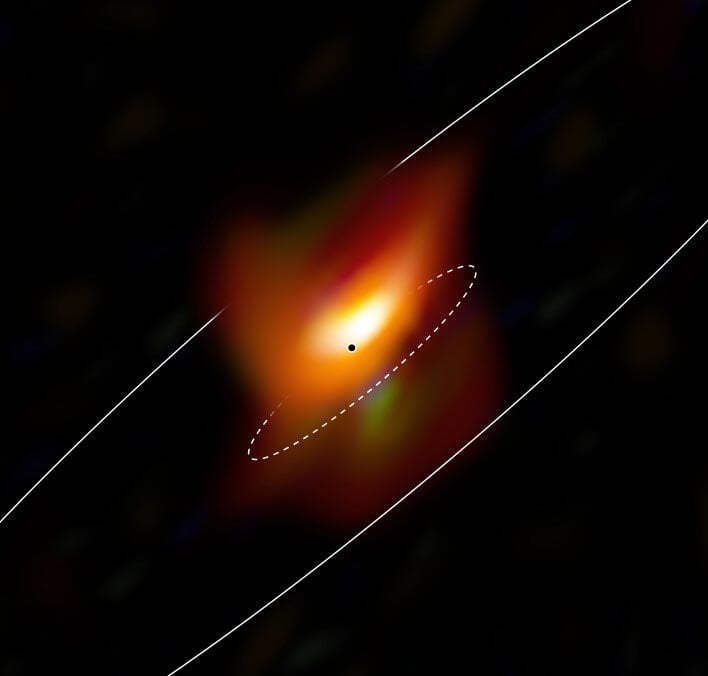
This image, captured with the MATISSE instrument on ESO’s Very Large Telescope Interferometer, shows the very inner region of the active galaxy Messier 77. Active galactic nuclei are extremely energetic sources powered by supermassive black holes. By making extraordinarily detailed observations of the active center of this galaxy, a team of astronomers detected a thick ring of cosmic dust and gas hiding a supermassive black hole. The black dot shows the most probable position of the black hole, while the two ellipses show the extent, seen in projection, of the thick inner dust ring (dashed) and extended dust disc. Credit: ESO/Jaffe, Gámez-Rosas et al.
According to this model, any difference in appearance between AGNs results from the orientation at which we view the black hole and its thick ring from Earth. The type of AGN we see depends on how much the ring obscures the black hole from our viewpoint, completely hiding it in some cases.
Astronomers had found some evidence to support the Unified Model before, including spotting warm dust at the center of Messier 77. However, doubts remained about whether this dust could completely hide a black hole and hence explain why this AGN shines less brightly in visible light than others.
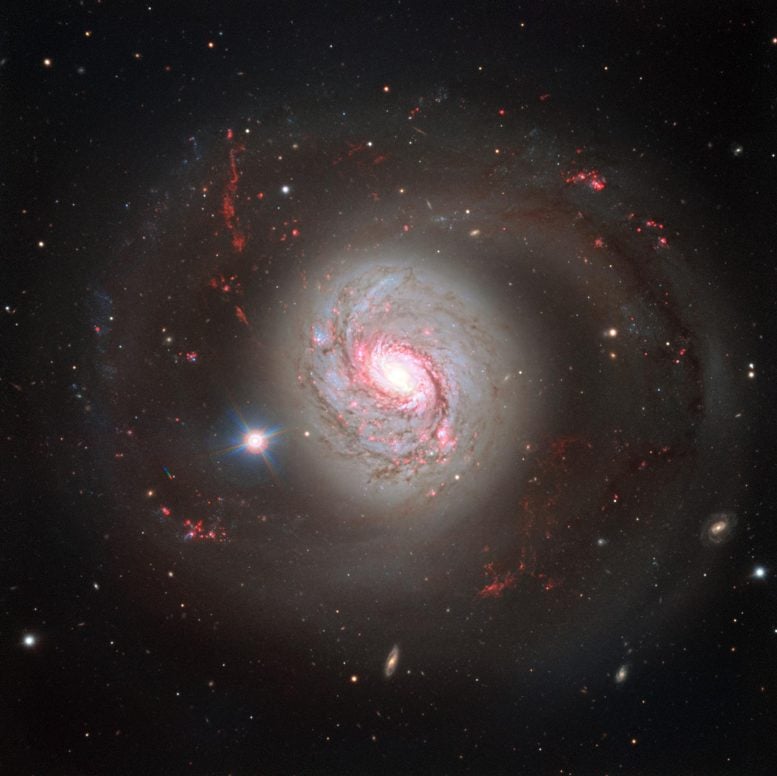
ESO’s Very Large Telescope (VLT) has captured a magnificent face-on view of the barred spiral galaxy Messier 77. The image does justice to the galaxy’s beauty, showcasing its glittering arms criss-crossed with dust lanes — but it fails to betray Messier 77’s turbulent nature. Credit: ESO
“The real nature of the dust clouds and their role in both feeding the black hole and determining how it looks when viewed from Earth have been central questions in AGN studies over the last three decades,” explains Gámez Rosas. “Whilst no single result will settle all the questions we have, we have taken a major step in understanding how AGNs work.”
The observations were made possible thanks to the Multi AperTure mid-Infrared SpectroScopic Experiment (MATISSE) mounted on ESO’s VLTI, located in Chile’s Atacama Desert. MATISSE combined infrared light collected by all four 8.2-meter telescopes of ESO’s Very Large Telescope (VLT) using a technique called interferometry. The team used MATISSE to scan the center of Messier 77, located 47 million light-years away in the constellation Cetus.
This animation shows what the core of Messier 77 might look like. As other active galactic nuclei, the central region of Messier 77 is powered by a black hole that is surrounded by a thin accretion disc, which itself is surrounded by a thick ring or torus of gas and dust. In the case of Messier 77, this thick ring completely obscures our view of the supermassive black hole. This active galactic nucleus is also believed to have jets, as well as dusty winds, that flow out of the region around the black hole perpendicularly to the accretion disc around it. Credit: ESO/M. Kornmesser and L. Calçada
“MATISSE can see a broad range of infrared wavelengths, which lets us see through the dust and accurately measure temperatures. Because the VLTI is in fact a very large interferometer, we have the resolution to see what’s going on even in galaxies as far away as Messier 77. The images we obtained detail the changes in temperature and absorption of the dust clouds around the black hole,” says co-author Walter Jaffe, a professor at Leiden University.
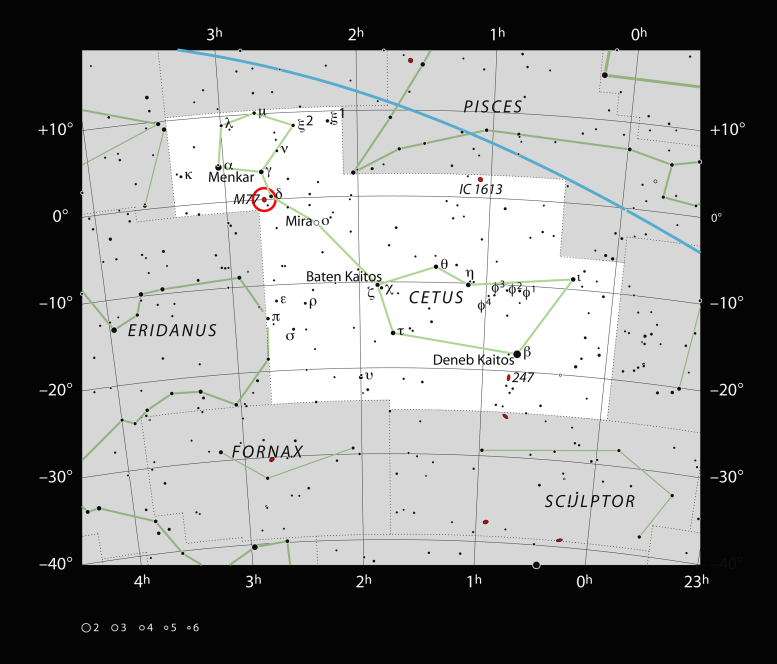
This chart shows the location of the active galaxy Messier 77 in the constellation of Cetus (The Sea Monster). It shows most stars visible to the unaided eye on a dark and clear night. Credit: ESO, IAU and Sky & Telescope
Combining the changes in dust temperature (from around room temperature to about 1200 °C) caused by the intense radiation from the black hole with the absorption maps, the team built up a detailed picture of the dust and pinpointed where the black hole must lie. The dust — in a thick inner ring and a more extended disc — with the black hole positioned at its center supports the Unified Model. The team also used data from the Atacama Large Millimeter/submillimeter Array, co-owned by ESO, and the National Radio Astronomy Observatory’s Very Long Baseline Array to construct their picture.
This animated infographic provides a simplified representation of the Unified Model of active galactic nuclei or AGNs, energetic sources powered by supermassive black holes that exist at the center of some galaxies.
Astronomers have observed different types of AGN. Some, called blazars, are exceedingly bright and can undergo changes in their brightness on timescales of only hours or days while another type, called quasars, are also very bright but tend to be less variable than blazars. Seyfert galaxies, which come in two flavors (1 and 2), are another type of AGN, which are surrounded by host galaxies that are clearly detectable. Seyfert 1 and Seyfert 2 galaxies both have bright cores, but Seyfert 2 tend to be more subdued.
The Unified Model of AGNs states that despite their differences, all AGNs have the same basic structure: a supermassive black hole surrounded by a thick ring or torus of dust. According to this model, any difference in appearance between AGNs results from the orientation at which we view the black hole and its thick ring from Earth. The type of AGN we see depends on how much the ring obscures the black hole from our view point, completely hiding it in some cases.
Credit: ESO/L. Calçada and M. Kornmesser
“Our results should lead to a better understanding of the inner workings of AGNs,” concludes Gámez Rosas. “They could also help us better understand the history of the
This image from the Digitized Sky Survey shows spiral galaxy Messier 77 and its surroundings. Messier 77 appears at the center and the edge-on galaxy NGC 1055 to its upper-right. Credit: NASA/ESA, Digitized Sky Survey 2
